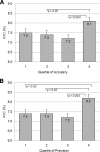Impact of carbohydrate counting on glycemic control in children with type 1 diabetes
- PMID: 19244089
- PMCID: PMC2681033
- DOI: 10.2337/dc08-2068
Impact of carbohydrate counting on glycemic control in children with type 1 diabetes
Abstract
Objective: To study the association between parent carbohydrate counting knowledge and glycemic control in youth with type 1 diabetes.
Research design and methods: We assessed 67 youth ages 4-12 years with type 1 diabetes (duration >or=1 year). Parents estimated carbohydrate content of children's meals in diet recalls. Ratios of parent estimates to computer analysis defined carbohydrate counting knowledge; the mean and SD of these ratios defined accuracy and precision, respectively. A1C defined glycemic control.
Results: Greater accuracy and precision were associated with lower A1C in bivariate analyses (P < 0.05). In a multivariate analysis (R(2)= 0.25, P = 0.007) adjusting for child age, sex, and type 1 diabetes duration, precision (P = 0.02) and more frequent blood glucose monitoring (P = 0.04), but not accuracy (P = 0.9), were associated with lower A1C. A1C was 0.8% lower (95% CI -0.1 to -1.4) among youth whose parents demonstrated precision.
Conclusions: Precision with carbohydrate counting and increased blood glucose monitoring were associated with lower A1C in children with type 1 diabetes.
Figures

Similar articles
-
Effects of Macronutrient Intake and Number of Meals on Glycemic Outcomes Over 1 Year in Youth with Type 1 Diabetes.Diabetes Technol Ther. 2024 Jun;26(6):420-425. doi: 10.1089/dia.2023.0464. Epub 2024 Feb 13. Diabetes Technol Ther. 2024. PMID: 38277162 Clinical Trial.
-
Randomized nutrition education intervention to improve carbohydrate counting in adolescents with type 1 diabetes study: is more intensive education needed?J Acad Nutr Diet. 2012 Nov;112(11):1736-46. doi: 10.1016/j.jand.2012.06.001. Epub 2012 Sep 11. J Acad Nutr Diet. 2012. PMID: 22975086 Free PMC article. Clinical Trial.
-
Associations of nutrient intake with glycemic control in youth with type 1 diabetes: differences by insulin regimen.Diabetes Technol Ther. 2014 Aug;16(8):512-8. doi: 10.1089/dia.2013.0389. Epub 2014 Apr 25. Diabetes Technol Ther. 2014. PMID: 24766666 Free PMC article.
-
Longitudinal associations of nutritional factors with glycated hemoglobin in youth with type 1 diabetes: the SEARCH Nutrition Ancillary Study.Am J Clin Nutr. 2015 Jun;101(6):1278-85. doi: 10.3945/ajcn.114.103747. Epub 2015 May 6. Am J Clin Nutr. 2015. PMID: 25948670 Free PMC article.
-
Carbohydrate-restricted diets and Type 1 diabetes mellitus: research considerations.Curr Opin Endocrinol Diabetes Obes. 2021 Oct 1;28(5):437-440. doi: 10.1097/MED.0000000000000669. Curr Opin Endocrinol Diabetes Obes. 2021. PMID: 34392261 Review.
Cited by
-
Accuracy of Carbohydrate Counting in Adults.Clin Diabetes. 2016 Jul;34(3):142-7. doi: 10.2337/diaclin.34.3.142. Clin Diabetes. 2016. PMID: 27621531 Free PMC article.
-
Insulin/carbohydrates ratio during the first 6-month therapy with insulin degludec in a paediatric population with type 1 diabetes previously treated with insulin glargine. An observational longitudinal study.Endocrinol Diabetes Metab. 2020 Mar 12;3(2):e00121. doi: 10.1002/edm2.121. eCollection 2020 Apr. Endocrinol Diabetes Metab. 2020. PMID: 32318639 Free PMC article.
-
Impact of Carbohydrate Counting Error on Glycemic Control in Open-Loop Management of Type 1 Diabetes: Quantitative Assessment Through an In Silico Trial.J Diabetes Sci Technol. 2022 Nov;16(6):1541-1549. doi: 10.1177/19322968211012392. Epub 2021 May 12. J Diabetes Sci Technol. 2022. PMID: 33978501 Free PMC article.
-
Psychological support for children with diabetes: are the guidelines being met?J Clin Psychol Med Settings. 2014 Jun;21(2):190-9. doi: 10.1007/s10880-014-9395-2. J Clin Psychol Med Settings. 2014. PMID: 24801493
-
Behavior-Analytic Approaches to the Management of Diabetes Mellitus: Current Status and Future Directions.Behav Anal Pract. 2020 Nov 10;14(1):240-252. doi: 10.1007/s40617-020-00488-x. eCollection 2021 Mar. Behav Anal Pract. 2020. PMID: 33732594 Free PMC article. Review.
References
-
- Anderson EJ, Richardson M, Castle G, Cercone S, Delahanty L, Lyon R, Mueller D, Snetselaar L: Nutrition interventions for intensive therapy in the Diabetes Control and Complications Trial: the DCCT Research Group. J Am Diet Assoc 1993; 93: 768– 772 - PubMed
-
- Delahanty LM, Halford BN: The role of diet behaviors in achieving improved glycemic control in intensively treated patients in the Diabetes Control and Complications Trial. Diabetes Care 1993; 16: 1453– 1458 - PubMed
-
- American Diabetes Association Nutrition recommendations and interventions for diabetes: a position statement of the American Diabetes Association. Diabetes Care 2007; 30( Suppl. 1): S48– S65 - PubMed
-
- Kawamura T: The importance of carbohydrate counting in the treatment of children with diabetes. Pediatr Diabetes 2007; 8( Suppl. 6): 57– 62 - PubMed
-
- Buzzard IM, Faucett CL, Jeffery RW, McBane L, McGovern P, Baxter JS, Shapiro AC, Blackburn GL, Chlebowski RT, Elashoff RM, Wynder EL: Monitoring dietary change in a low-fat diet intervention study: advantages of using 24-hour dietary recalls vs food records. J Am Diet Assoc 1996; 96: 574– 579 - PubMed
Publication types
MeSH terms
Substances
Grants and funding
LinkOut - more resources
Full Text Sources
Other Literature Sources
Medical

